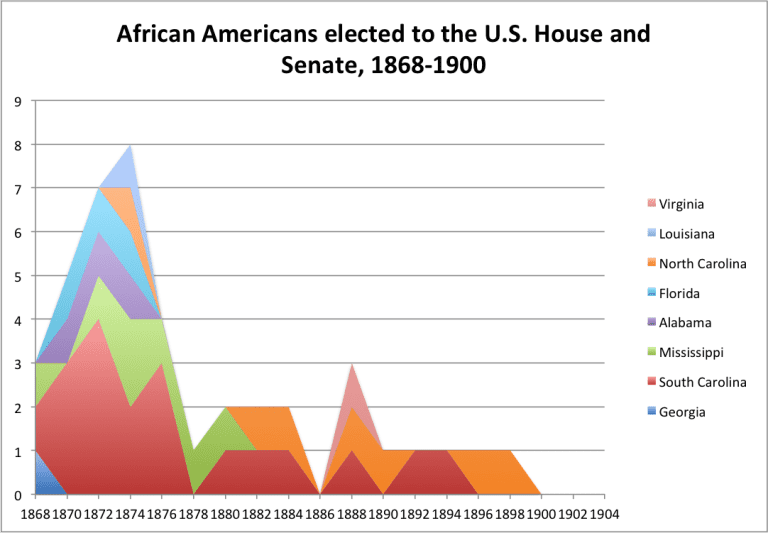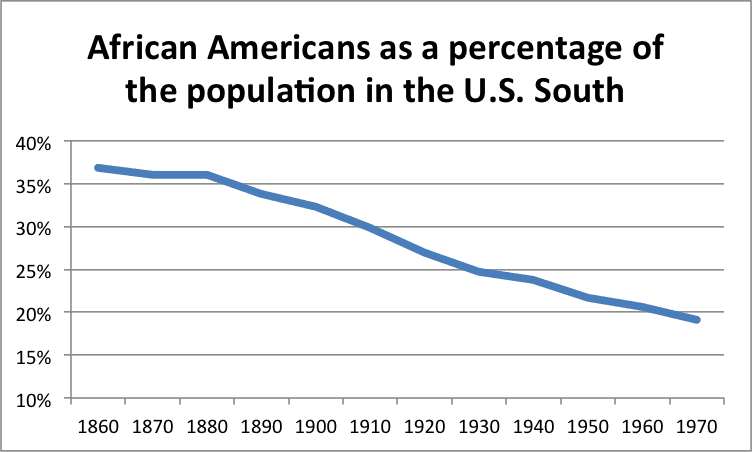I find it confusing when I hear people say that we shouldn’t take down Confederate monuments, because that would be erasing history. Let me illustrate. Earlier this month Baltimore quietly removed four Confederate statues in the middle of the night. I’m left wondering: Why did Baltimore even have Confederate monuments? Maryland didn’t secede. Maryland was a border state. While some Maryland residents left the state and enlisted in the Confederacy, the majority of those who fought enlisted in the Union army. Having Confederate monuments in Maryland is, if anything, ahistorical.
These monuments, you see, weren’t actually about history. They were about showing who was in charge. Most were erected between 1900 and 1920, during a period of Jim Crow laws, lynching, and voter suppression.
Have a look at this chart:

This chart flatlines in 1900—when a full third of the population of the South was black, but the region’s U.S. Congressmen and Senators were universally white. After this, there wasn’t another African American elected to the U.S. House or Senate for a full thirty years.
If African Americans in the South were shut out on the federal level, what do you think happened in state and local elections? In 1871 and 1872 the Virginia legislature had a handful of black members. By 1900 it was lily white, despite the state’s population being over one-third black. Who do you think was putting up these monuments at courthouses and other government locations?
During and after Reconstruction, racist white southerners seized control of local and state governments, massacred African Americans who fought for the right to vote and live as free and equal people, and imposed a harsh regime of segregation, repression, and violence on the region’s African American population. It was these individuals, and their children—raised on tales of the “Lost Cause” that glorified the “Old South”—who erected the region’s Confederate monuments.
It wasn’t about history. It was about asserting dominance.
The South was not a good place for African Americans from the late nineteenth century and well into the twentieth century. Many of those who could left, fleeing oppression and looking for a better life in the North and the West, often settling in cities like Chicago, Detroit, or New York. This “Great Migration” of African Americans from the South to the North was sizable:

The first African American to enter U.S. Congress in the twentieth century did so from the North: Oscar De Priest was elected in 1928 in Chicago, Illinois. De Priest passed his seat on to others, but African Americans didn’t add a second seat until Adam Powell, Jr., was elected in 1944 in New York City. Next came a seat in Michigan in 1954, a seat in Pennsylvania in 1956, and a seat in California in 1962, each time in urban areas.
Despite the South continued to be home to the greatest concentration of African Americans in the nation, the first African American to enter U.S. Congress in the twentieth century from the South was not elected until 1972.
Let me pose a question. If these Confederate monuments are about history rather than propaganda, where are the monuments to those African Americans elected to local, state, and federal office before blacks in the South had their voting rights terminated? Where are the monuments to antebellum slaves, or to those who resisted and fought back?
Where is the monuments to Gabriel Prosser, mastermind of a failed rebellion planned to bring freedom to the slaves of Virginia? There’s a bland historical marker, but no monument. Why? There’s a story there.
In 2000, bicentennial celebrations stirred fresh controversy: the Caroline County Board of Supervisors rejected a petition from Gabriel’s supporters to honor him on a courthouse monument, stating that any memorialization would glorify violence.
Yes, really.
Erecting a monument to a slave who plotted to capture James Monroe, the Governor of Virginia, and demand freedom for his people would be “glorifying violence,” but Confederate monuments are a-okay. Just so we’re clear, there is a Confederate monument at the Caroline County courthouse. “Erected by the people of Caroline County,” it reads, “to Commemorate the Valor and Endurance of its soldiers furnished to the Army of the Confederate States of America.” So much for not glorifying violence.
This isn’t about history. It never was about history. The Confederate monuments that dot the South have always been about propaganda and white supremacy.










